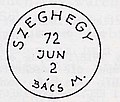Lovćenac
Lovćenac
Ловћенац ( UTC+2 (CEST ) |
|---|

Lovćenac (Serbian Cyrillic: Ловћенац) is a village located in the Mali Iđoš municipality, in the North Bačka District of Vojvodina, Serbia. The village is known as the de facto capital of Montenegrins in Serbia, and has a total population of 3,161 people (2011 census).
Name
In Serbian, the village is known as Lovćenac (Ловћенац), in German as Sekitsch (in the past rarely Winkelsberg), and in Hungarian as Szeghegy.
Its former name in
The original Hungarian name of the village was Szeghegy, but Hungarians also used Serbian version of the name in the forms Szikics and Szekics, as well as Germans in the form Sekitsch. One very rare alternative German name was Winkelsberg.
History
After years of
Following World War I and the collapse of the Austro-Hungarian Empire, Sekitsch became part of the Kingdom of Serbs, Croats and Slovenes (later renamed Yugoslavia). This political shift caused ethnic Germans to become one of the largest minorities in Serbia, numbering approximately 330,000 people, or almost 5% of the total Yugoslav population. In 1936 the Summer Olympics torch relay passes through Sekitsch.[9] During the April War of 1941 Hungarian troops entered Sekitsch, subsequently annexing the Bačka to the Kingdom of Hungary. As declared Volksdeutsche the villagers were tolerated by the new authority, though mandatory conscription in the Waffen SS was conducted. Sekitsch also harboured urban children as part of the Kinderlandverschickung program.[10]
Following the war Germans left the country, together with the defeated German army. Those who remained were interned into prison camps. After camps were disbanded in 1948, most of the remaining Yugoslav Germans emigrated to Germany because of economic reasons in the next decades. After World War II, the village was colonized by settlers from
Demographics
Ethnic groups
Ethnic composition of Lovćenac inhabitants according to the 2002 Republic of Serbia census. Village population 3,693
The village of Lovćenac is predominantly inhabited by descendants of
Historical population
- 1822: 1,751
- 1850: 2,825
- 1970: 3,377
- 1885: 4,485
- 1900: 4,936
- 1910: 5,394
- 1945: 4,447
- 1948: 4,791
- 1961: 4,800
- 1971: 4,159
- 1981: 4,016
- 1991: 4,049
- 2002: 3,693
- 2011: 3,161
Culture
Village cultural life features several societies which strive to maintain and celebrate the diverse identity and traditions of Lovćenac. Being the epicentre of the
Notable people
- Mitar Pešikan, linguist and member of the Serbian Academy of Sciences and Arts
- Sofija Pekić, former female Serbian basketball player, Olympic bronze medalist
- Danilo Popivoda, Slovenian football player of Serbian descent
- Nenad Stevović, politician
- Radovan Stevović, author, Yugoslav Partisan and Montenegrin colonist leader
- Peter Max Wagner, Danube Swabian humanitarian and refugee advocate
Twin towns – Sister cities
Lovćenac is
 Cetinje, Montenegro
Cetinje, Montenegro Bar, Montenegro
Bar, Montenegro
See also
- Montenegrins of Serbia
- List of places in Serbia
- List of cities, towns and villages in Vojvodina
Notes
- ^ "Sekitsch in the Batschka | Szeghegy (Sekitsch) by Johan Jauß". www.dvhh.org. Retrieved 2022-01-21.
- ^ "Sekitsch in the Batschka | Ortsippenbuch Sekitsch". www.dvhh.org. Retrieved 2022-01-21.
- ^ "Sekitsch in the Batschka | The Colonial Families of Sekitsch". www.dvhh.org. Retrieved 2022-01-21.
- ^ "Sekitscher Ortsgeschichte". www.sekitsch.de. Retrieved 2022-01-21.
- ^ Dr Dušan J. Popović, Srbi u Vojvodini, knjiga 1, Novi Sad, 1990, page 113.
- ^ Slobodan Ćurčić, Broj stanovnika Vojvodine, Novi Sad, 1996, page 122.
- ^ "Sekitscher Ereignisse". sekitsch.com. Retrieved 2022-01-21.
- ^ Chrisbbb (2021-09-22). "Bloody Big BATTLES Blog: Hungary 1848 #11: Hegyes". Bloody Big BATTLES Blog. Retrieved 2022-01-21.
- ^ "The Danube Swabian Resources Website". www.danube-swabians.org. Retrieved 2022-01-28.
- ^ "Dorfchronik - Startseite de". www.sekitsch-feketitsch.de. Retrieved 2022-01-28.
- ^ "Влашић - Ловћенац". Влашић - Ловћенац (in Serbian). Retrieved 2020-06-30.
- ^ Welle (www.dw.com), Deutsche. "Vojvođanski Crnogorci u grotlu prisajedinjenja | DW | 23.11.2018". DW.COM (in Serbian). Retrieved 2020-06-30.
- ^ "Crnogorci u Srbiji nijesu tuđinci". CdM. 2019-07-13. Retrieved 2020-06-30.
- ^ Гаћеша, Никола (1984). Аграрга реформа и колонизација у Југославији 1945–1948. Нови Сад.
{{cite book}}: CS1 maint: location missing publisher (link) - ^ "Udruženja Crnogoraca Srbije Krstaš Архиве". Moja Crna Gora (in Serbian). Retrieved 2022-01-15.
- ^ "Влашић - Ловћенац". Влашић - Ловћенац (in Serbian). Retrieved 2022-01-15.
- ^ "Zavičajno udruženje „Vlašić" iz Lovćenca". Moja Backa Topola (in Serbian). 2018-12-29. Retrieved 2022-01-15.
- ^ "Museum Sekitsch". www.sekitsch-feketitsch.de. Retrieved 2022-01-15.
- ^ "Sekitsch in the Batschka | Ortsippenbuch Sekitsch". www.dvhh.org. Retrieved 2022-01-18.
- ^ "Opština Mali Iđoš". maliidjos.rs. Retrieved 2022-01-15.
- ^ Попивода, Жељко (2015-06-03). "Црква у Ловћенцу". Жељко Попивода (in Serbian). Retrieved 2022-01-15.
References
- Slobodan Ćurčić, Broj stanovnika Vojvodine, Novi Sad, 1996.
Gallery
-
An intersection on the main road in Lovćenac today.
-
Memorial for soldiers from Lovćenac who died in World War I.
-
This memorial, referred to as "de Steen", was erected in 1895 to commemorate those who died in a 1849 battle near Lovćenac.
-
Sekić got its first post office in 1872.
External links
- Krstaš
- Mi smo Crnogorci, sa azbukom od 33 slova, Glas javnosti, 5 February 2006 (about Montenegrins of the village)






